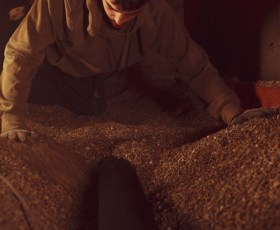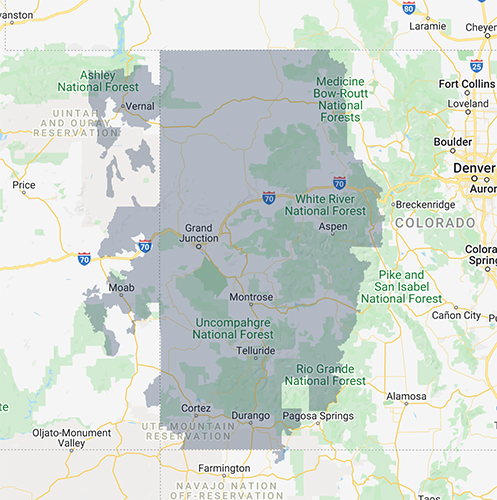High electric bills, poor air quality, and pests may be indicators that there’s something amiss in your crawl space. Crawl space vents tend to be the culprit, as it was commonly believed from the mid-20th century to the early 1990s that crawl space vents were needed to regulate the temperature in the space below your home. Now, we know that vents are the cause of crawl space issues, as it provides an opening for problem signs to sneak their way in.
Crawl Space Problem Signs
Foundation Repair of Western Colorado

Crawl Space Mold
Mold forms in any moist environment. Unfortunately, this can include crawl spaces in Grand Junction, Colorado. In fact, mold is a problem sign of crawl space damage.
Foundation Repair of Western Colorado

Sagging Floors
Sagging floors are a fundamental problem sign for any property, no matter how slight the unevenness is. Here’s what you need to know about sagging flooring and how to fix it.
Foundation Repair of Western Colorado

Wood Rot
Wood rot is a common issue in damp and humid crawl spaces, but if you learn to identify it early, you could avoid many of the worst issues that are often connected to it.
Causes
Crawl space problems can weak havoc to the rest of your home, learn more about what causes your crawl space to become damaged.
Of all the things that can seriously impact and damage your home, the stack effect is one of the least commonly discussed by professionals and homeowners alike. This may be because of the relatively invisible nature of the issue, but being hard to spot doesn’t make it any less dangerous. In fact, the stack effect is one of the most dangerous issues a property can deal with because it impacts every area of a home.
Homes dealing with the stack effect are more likely to suffer from dampness, humidity, and all of the many issues that are commonly connected to them. As such, it is advisable for homeowners to know what the stack effect is, what causes it, how it affects a property and the problem signs that are likely to show themselves. If you want to protect your Grand Junction, Colorado, home from the stack effect this is what you need to know.

What Is the Stack Effect?
Sometimes called the chimney effect, the stack effect is essentially a phenomenon that drives airflow through a property at an accelerated rate. By impacting the rate and speed of airflow, as well as creating channels of moving air in a property, the stack effect impacts every part of a home. This is caused by thermal differences in the air inside and outside of your property but requires corresponding ventilation points in order to take effect.
A property that is dealing with the stack effect will find that airflow works in one of two ways and will either bring in cold air from the bottom of the property or pull in warm air from the top of the property, depending on the season and how you are using your HVAC system. Whether the stack effect is making your home colder or warmer, however, it poses a risk to every part of your property.
How the Stack Effect Works
In order to take effect, the stack effect requires ventilation points at both the lowest and highest levels of a property. It is reliant on how thermal changes impact the air in a property. The ideal is for a property to exist at a neutral pressure level (NPL). This means that the air pressure inside the property is the same as the pressure outside. When this happens, the climate in your home will be stable and airflow will be minimized, allowing for consistent heating and cooling.
The stack effect disrupts this by allowing artificially heated or cooled air to escape a property and draw in air from outside the home. This impacts your energy efficiency and HVAC system, but can also cause dampness, spread germs and bacteria, and generally make your home unhealthy and uncomfortable. As such, it is best to deal with the stack effect as soon as you notice it.
What Can Cause the Stack Effect?
While the stack effect requires corresponding ventilation points in a home, the actual causes can vary. After all, not all ventilation points are installed intentionally. Any gap in the structure of your property can allow enough airflow to create a stack or chimney effect. In most Grand Junction, Colorado, homes the cause is uncovered crawl space vents.
What You Need To Know About Open Vents
Crawl space vents were installed in properties across the U.S. between the 1950s and 1990s because they were believed to increase airflow and prevent dampness and humidity in a property. They do increase airflow (they cause the stack effect, after all), but this was later found to be actively damaging to a home. As such, vent covers are commonly found in properties that previously had exposed crawl space vents.
Simply covering your vents is not a good idea. Vent covers are best installed as a part of a wider process of waterproofing and insulation, as this will deal with the issues that the stack effect can cause. If you have an external access point that is generally unsealed, you can also get crawl space doors that allow access while sealing the space properly.
Structural Damage and the Stack Effect
While the stack effect is caused by unsealed vents in the vast majority of cases, there is a possibility that the increase in airflow is being caused by structural damage or weaknesses of some kind. After all, all the stack effect requires is a gap big enough to allow significant airflow. This can be caused by many different issues in a home.
For example, movement in the structure of your home can lead to gaps between your floors and walls or cause large cracks to open up. This can allow increased airflow. Likewise, damage to the sealant around utility inlets and window frames can contribute to the formation of the conditions needed for the stack effect in a home.
Why Worry About the Stack Effect?
So what’s the real issue with the stack effect? The main side effect of this issue is a change in airflow, after all. This may not seem like a big issue, but it could actually be the cause of a lot of damage and grief in your home when allowed to percolate. Here are some of the issues that can arise as a result of the stack effect:
Lower Energy Efficiency
One of the most subtle and frustrating issues connected to the stack effect is a general reduction in energy efficiency as a result of increased humidity and lowered stability. This makes your HVAC system, in particular, work harder to produce the same results and will cause increased wear and tear as well as higher energy usage.
Higher energy consumption means that your energy bill will start to rise over time. In fact, the issue can lead to quite a sharp increase in your costs.
Increased Humidity
One of the main side effects of the stack effect in a home is an increase in humidity in a property. This happens because of how air reacts to thermal changes. When your HVAC system heats the air in your home, it rises. This leads to it exiting the home and drawing in cold air from outside. Likewise, when your HVAC is cooling air in your home, it will sink and draw in warm air from above.
This leads to condensation as the cold and warm air clash and moisture is displaced, gathering on cool surfaces. This creates a generally damp atmosphere and can contribute to the formation of mold and the spread of wood rot. Finally, while this may not seem like a big issue, humidity is incredibly uncomfortable for many people and will make your home less pleasant to be in.
Mold and Mildew Formation
Mold and mildew go hand in hand with the stack effect in many cases. That’s because of how it brings moisture and spores into a property that would otherwise be sealed. Fungal spores of all kinds really only need organic material and moisture to thrive, and once they take root, they will spread with alarming speed.
Most forms of mold are not harmful to wood, but some can be incredibly toxic to people and animals. Black mold is the most seriously toxic and can cause skin and eye irritation, respiratory infections, migraines, and even seizures. Wood rot fungi, by contrast, are generally not toxic to people but will cause serious damage to the wooden surfaces in a home.
Airborne Allergen Invasion
A slightly less severe issue than fungal growth, the incursion of airborne allergens into a home that is being impacted by the stack effect nonetheless makes the interior climate uncomfortable for anyone with allergies. For those with hay fever and seasonal allergies, living in a property that is dealing with the stack effect can be hellish.
For those who have compromised immune systems, however, this is more of an issue. Even when mold and mildew aren’t present, the increase in allergens and airborne germs may lead to people in these homes becoming sick more often. As such, it is best to act quickly and deal with the stack effect when it first presents itself.
Fluctuating Interior Temperatures
Finally, the stack effect in a property will lead to fluctuating temperatures and a generally unstable climate. This happens because the artificially heated or cooled air is continually being pulled or pushed from a home by the stack effect and being replaced by air from outside. This means that your HVAC system will be unable to create consistent temperatures.
This is especially concerning in winter. The Colorado winters can be fairly harsh, and the frequent fluctuations in temperature can cause illness in those who are vulnerable, as well as general discomfort for everyone else on a property. The most worrying possible outcome of this, however, is that the cold in your crawl space suddenly reaches a breaking point and causes a snap freeze in your pipes. This will cause some pipes to burst and lead to a plumbing flood.
Each of these issues can cause more problems of its own. This will create a wide net of issues throughout your home and lead to serious deterioration within your home. Learning to spot the problem signs of damage is all-important to preventing ongoing issues in your home.
Problem Signs To Look For
Spotting the stack effect is very tough if you do not know what you are looking for, but the issues it can cause are generally less subtle. Here’s what you should be looking out for in your home:
- Drafts
- Slamming doors
- Condensation
- Sudden temperature changes
- Mold formation
- Wood rot
If you see any of these issues, or you see more than one in conjunction, please reach out to a professional to make sure that you are aware of all the issues that could be at work in your home. Acting quickly could save you a lot of time and money.
Stack Effect
FAQs
Yes. You can put a stop to the stack effect in your home and prevent it from impacting your property in the future. It’s all a matter of waterproofing, encapsulation, and proper and regular maintenance within your crawl space and property as a whole. The stack effect may be common, but it is not inevitable.
Waterproofing and Encapsulation
Crawl space encapsulation and waterproofing are the most reliable ways in which to prevent the stack effect (as well as a number of other issues) from damaging your home as a whole. Covering exposed vents is a large part of this process, but there is a lot more to it. As such, there are many different benefits to undertaking this process. Better still, this is not a hugely lengthy or invasive process; crawl space encapsulation can generally be undertaken in a day or less.
The benefits of waterproofing and encapsulation go far beyond the prevention of the stack effect. Homes with fully encapsulated crawl spaces are less at risk of dampness, mold formation, and pest infestation. They also enjoy generally higher levels of heat and cold retention and will be more energy efficient as a result. Encapsulated crawl spaces can even be used for seasonal storage.
Maintenance
Once waterproofing and encapsulation have been undertaken, maintaining the products and appliances that were used will be key to preventing a recurrence of the stack effect and its associated issues. A robust and regular maintenance schedule will ensure the benefits of your crawl space encapsulation process last. After all, while most insulation will last indefinitely, sump pumps have a life span of roughly eight to 12 years.
As such, you should make seasonal inspections of your crawl space, drains, sump pump, and dehumidifier to look for signs of damage. Likewise, booking a maintenance appointment for your appliances on a seasonal basis will ensure that small issues are rectified quickly before they can snowball into larger ones. This will save you time, money, and stress in the long term.
There can be cases in which the stack effect is a minor issue or has a negligible impact, but it can never really be classed as benign or positive. This is a fundamentally disruptive process that will cause deterioration throughout your home if you let it.
Cumulative Damage
The stack effect is a subtle issue that does not always seem to be a problem until it is too late. The damage that it does to a property is cumulative and grows exponentially past a certain point. For example, the stack effect causes condensation. This alone is not a huge issue, but condensation increases humidity and creates dampness. This can allow mold and wood rot fungi to flourish.
By the time mold has formed or wood rot has taken root, the damage is likely to have spread to other parts of a home. If left to grow unchecked, these issues can cause health problems and even lead to structural collapse in and around an affected property. So as you can see, acting quickly is key when it comes to the stack effect. Time really is money when it comes to these kinds of issues.
Health Concerns
Structural damage is a concern for any homeowner, but the stack effect can have far more concerning implications for your health. A home dealing with the stack effect is more likely to deal with airborne allergens, bacteria, and a generally unstable or unpleasant climate. For those who are healthy, this is not necessarily a big issue. However, there are those who are more vulnerable to consider.
People who have underlying health conditions that impact their immune system, those undergoing intensive cancer treatments, and those with respiratory issues like emphysema and bronchitis are all at a higher risk of infection and illness in a home that is dealing with the stack effect. This can cause minor discomfort and illness but can also cause serious reactions and even lead to hospitalization (especially if there is black mold in a home).
While we understand the temptation of using DIY to save money and time, we recommend that you do not try to undertake waterproofing and encapsulation alone. If you try to go it alone, you could cause more damage or run into issues you are not equipped to handle.
The Dangers of DIY
There are many different issues with DIY when it comes to waterproofing, but the most pressing is the fact that your crawl space must be in good health before you can begin. This may seem like a small thing to ask for, but many crawl spaces that have been exposed for a number of years have hidden issues and structural damages that are complex and hard to repair without professional training and tools. The most serious example of this is foundation damage.
If you try to deal with serious structural damage alone, you could end up causing more damage to your home or even cause injury to yourself and anyone helping you. This is partly because of the instability of damaged structures and the likelihood of collapse should you put pressure on the wrong part of a damaged surface, but also because of the nature of the equipment. Issues like foundation damage often need heavy excavation equipment, as well as specialist tools that most homeowners simply will not know how to use.
Professionals Get Results
As well as being trained to deal with all of the underlying issues that can be found in any crawl space, professionals have the tools and equipment that they need on hand already. This actually brings the cost down, as you will have to hire these tools if you try to go it alone. This experience is what enables professionals to work quickly and effectively in cramped conditions that the average crawl space offers. They are also able to get the best waterproofing products from professional supply stores or even direct from the manufacturer. Finally, hiring a professional offers a level of convenience and confidence that DIY repairs simply cannot.
Yes. You can put a stop to the stack effect in your home and prevent it from impacting your property in the future. It\u2019s all a matter of waterproofing, encapsulation, and proper and regular maintenance within your crawl space and property as a whole. The stack effect may be common, but it is not inevitable.
\n\n\n\nWaterproofing and Encapsulation\u00a0
\n\n\n\nCrawl space encapsulation and waterproofing are the most reliable ways in which to prevent the stack effect (as well as a number of other issues) from damaging your home as a whole. Covering exposed vents is a large part of this process, but there is a lot more to it. As such, there are many different benefits to undertaking this process. Better still, this is not a hugely lengthy or invasive process; crawl space encapsulation can generally be undertaken in a day or less.
\n\n\n\nThe benefits of waterproofing and encapsulation go far beyond the prevention of the stack effect. Homes with fully encapsulated crawl spaces are less at risk of dampness, mold formation, and pest infestation. They also enjoy generally higher levels of heat and cold retention and will be more energy efficient as a result. Encapsulated crawl spaces can even be used for seasonal storage.
\n\n\n\nMaintenance\u00a0
\n\n\n\nOnce waterproofing and encapsulation have been undertaken, maintaining the products and appliances that were used will be key to preventing a recurrence of the stack effect and its associated issues. A robust and regular maintenance schedule will ensure the benefits of your crawl space encapsulation process last. After all, while most insulation will last indefinitely, sump pumps have a life span of roughly eight to 12 years.
\n\n\n\nAs such, you should make seasonal inspections of your crawl space, drains, sump pump, and dehumidifier to look for signs of damage. Likewise, booking a maintenance appointment for your appliances on a seasonal basis will ensure that small issues are rectified quickly before they can snowball into larger ones. This will save you time, money, and stress in the long term.
\n” } }, { “@type”: “Question”, “name”: “Is the Stack Effect Always a Bad Thing?”, “acceptedAnswer”: { “@type”: “Answer”, “text”: “\nThere can be cases in which the stack effect is a minor issue or has a negligible impact, but it can never really be classed as benign or positive. This is a fundamentally disruptive process that will cause deterioration throughout your home if you let it.
\n\n\n\nCumulative Damage\u00a0
\n\n\n\nThe stack effect is a subtle issue that does not always seem to be a problem until it is too late. The damage that it does to a property is cumulative and grows exponentially past a certain point. For example, the stack effect causes condensation. This alone is not a huge issue, but condensation increases humidity and creates dampness. This can allow mold and wood rot fungi to flourish.
\n\n\n\nBy the time mold has formed or wood rot has taken root, the damage is likely to have spread to other parts of a home. If left to grow unchecked, these issues can cause health problems and even lead to structural collapse in and around an affected property. So as you can see, acting quickly is key when it comes to the stack effect. Time really is money when it comes to these kinds of issues.
\n\n\n\nHealth Concerns\u00a0
\n\n\n\nStructural damage is a concern for any homeowner, but the stack effect can have far more concerning implications for your health. A home dealing with the stack effect is more likely to deal with airborne allergens, bacteria, and a generally unstable or unpleasant climate. For those who are healthy, this is not necessarily a big issue. However, there are those who are more vulnerable to consider.
\n\n\n\nPeople who have underlying health conditions that impact their immune system, those undergoing intensive cancer treatments, and those with respiratory issues like emphysema and bronchitis are all at a higher risk of infection and illness in a home that is dealing with the stack effect. This can cause minor discomfort and illness but can also cause serious reactions and even lead to hospitalization (especially if there is black mold in a home).
\n” } }, { “@type”: “Question”, “name”: “Can I Waterproof Alone?”, “acceptedAnswer”: { “@type”: “Answer”, “text”: “\nWhile we understand the temptation of using DIY to save money and time, we recommend that you do not try to undertake waterproofing and encapsulation alone. If you try to go it alone, you could cause more damage or run into issues you are not equipped to handle.
\n\n\n\nThe Dangers of DIY\u00a0
\n\n\n\nThere are many different issues with DIY when it comes to waterproofing, but the most pressing is the fact that your crawl space must be in good health before you can begin. This may seem like a small thing to ask for, but many crawl spaces that have been exposed for a number of years have hidden issues and structural damages that are complex and hard to repair without professional training and tools. The most serious example of this is foundation damage.
\n\n\n\nIf you try to deal with serious structural damage alone, you could end up causing more damage to your home or even cause injury to yourself and anyone helping you. This is partly because of the instability of damaged structures and the likelihood of collapse should you put pressure on the wrong part of a damaged surface, but also because of the nature of the equipment. Issues like foundation damage often need heavy excavation equipment, as well as specialist tools that most homeowners simply will not know how to use.
\n\n\n\nProfessionals Get Results\u00a0
\n\n\n\nAs well as being trained to deal with all of the underlying issues that can be found in any crawl space, professionals have the tools and equipment that they need on hand already. This actually brings the cost down, as you will have to hire these tools if you try to go it alone. This experience is what enables professionals to work quickly and effectively in cramped conditions that the average crawl space offers. They are also able to get the best waterproofing products from professional supply stores or even direct from the manufacturer. Finally, hiring a professional offers a level of convenience and confidence that DIY repairs simply cannot.
\n” } } ] }Call Foundation Repair of Western Colorado for Crawl Space Repair & Encapsulation
If you have uncovered crawl space vents or damage to your home that you think may be contributing to the presence of a stack effect in your property, please reach out to Foundation Repair of Western Colorado immediately. Our team has years of collective experience and has been helping homeowners in this area since 2005. You can rely on us to know just what to do, no matter how complex the situation is.
All you need to do in order to start the repair process is book a free inspection appointment online or by calling directly. Our team will arrange an appointment for a time and date that suits you. Once they arrive, they will assess your home for signs of dampness and damage and provide you with a written estimate for the cost of their suggested solutions. This is provided to ensure that you have all the information that you need to make an informed decision about what is best for your home.
Mold, a fungus that grows extremely well in moist environments, can eat away at some of the vital structures in your home. While this does require a long time to happen, if left unchecked, mold can lead to serious consequences. Most homeowners tend to neglect their crawl spaces because they do not use them very often, nor feel as if they have the need to check on them. This is one of the reasons why crawl space mold is so common. If one is not adamant about maintaining their crawl space, mold and other problems can arise and quickly escalate.
If you live in Grand Junction, Colorado, you know more than anyone that it is one of the drier cities in Colorado. You may be wondering how crawl space mold could be a problem for you, especially since there is very little rain and the climate is semi-arid. However, mold can manifest in crawl spaces in Colorado due to the significant amount of snow that falls during the winter. The average annual snowfall is 15.8 inches. When this amount of snow melts, it can produce a large quantity of water that can invade your crawl space and increase the likelihood of mold growth.
Signs That You May Need Crawl Space Encapslation
Fortunately, there are many warning signs that one can watch out for before major structural damages happen. Some of them are subtle, while others are more prominent.
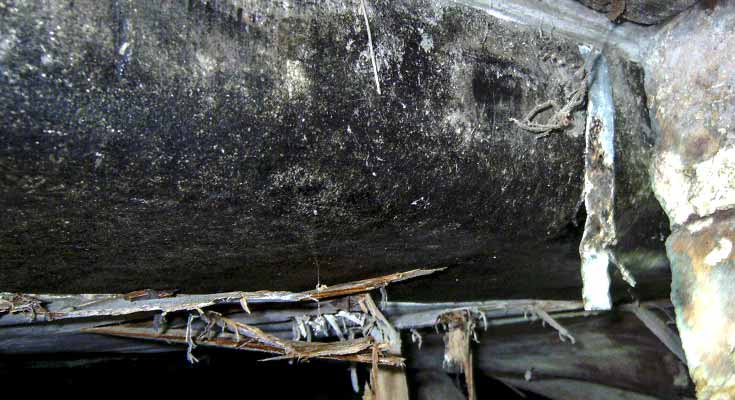
Mold Growth
Mold growth is considered to be one of the more subtle problem signs of crawl space issues, but it can also become easily noticeable if left unchecked. Mold is a type of fungus that thrives in wet environments. This is why you are likely to find mold in areas that have a lot of moisture in the air or in areas that are constantly under exposure to high volumes of water.
There are also certain materials that are more likely to host mold growth. This can include various plant-like materials, such as wood or drywall because they contain lots of pores for the fungus to grow in, as well as the nutrients it needs to survive. Wood, for instance, can also retain much more water than concrete or stone. This can further aid the growth of mold.
Most crawl spaces contain wooden support structures and concrete walls. Since your crawl space is always exposed to the elements, water can easily enter your crawl space and become absorbed into these wooden posts. This is especially likely during the onset of spring and later into the summer, where the snow from winter melts and enters your crawl space. Furthermore, water can also increase the humidity levels within your crawl space. This moisture is an invitation for mold to grow.
Mold on wood looks spotty or splotchy and is black or grey in color. It also looks very similar on concrete, but mold on concrete can also appear striped. Sometimes, it looks like the normal discoloration of concrete, so it can be more difficult to tell. Mildew, another common type of mold, can look white, powdery, and even fluffy.
Musty Odors
Unpleasant smells coming from your crawl space are another subtle problem sign that you need crawl space encapsulation. Musty odors tend to come from the growth of mold. Therefore, if you notice funny smells coming from below your house, it is likely that there is also mold growing down there.
Mold gives off a certain smell because they release chemical compounds into the air as they proliferate. These chemical compounds, also known as microbial volatile organic compounds (MVOCs), are what produce the musty odors you smell. Although this sounds rather dangerous, it is more of a sign that you have mold growth somewhere in your home. You should not be overly worried about it, as long as you can find the mold and remove it.
Pests
Moisture can also draw unwanted pests to your home. Common household pests that are drawn to moist environments include, but are not limited to:
- Cockroaches
- Earwigs
- Silverfish
- Ants
- Termites
If you notice a pest infestation in your home with no notable cause, you may want to check the condition of your crawl space. It is likely that they have entered your living space through your crawl space due to the inviting wet environment.
Water Damage
Water damage is the most common trouble sign that your crawl space needs encapsulation. Water damage manifests in various ways, such as:
- Wood rot
- Efflorescence
- Cracks in concrete or wood
- Soil shrinkage, compaction, and settlement
- Sunken floors
- Mold
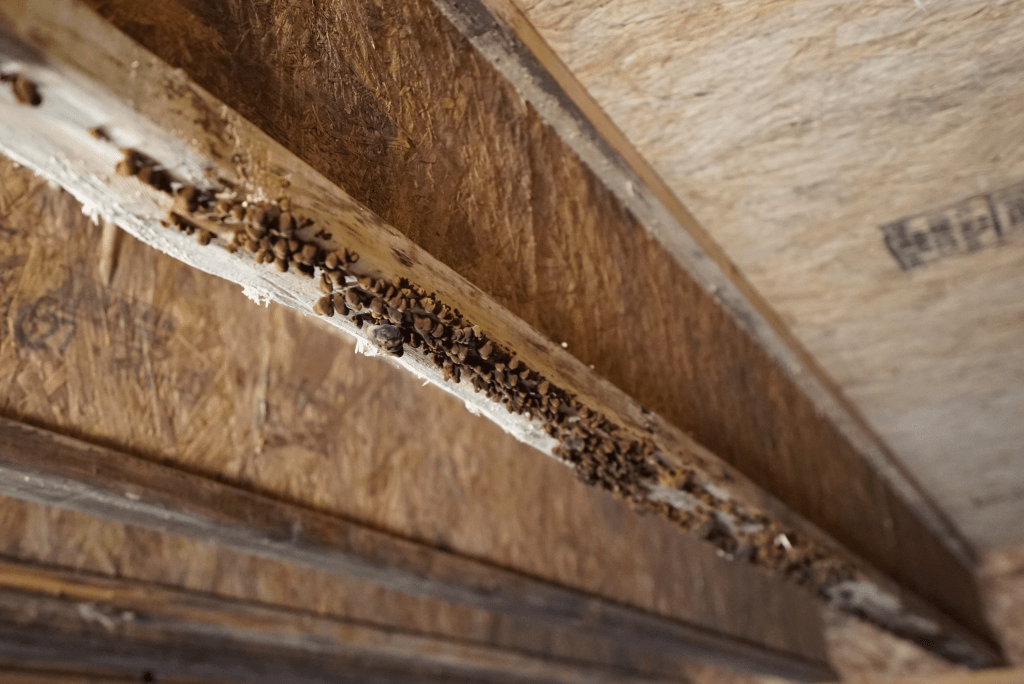
Poor Air Quality
Your crawl space’s air quality is more important than one may think. In fact, the quality of your crawl space air can impact the air quality inside your home as well. For instance, if the air within your crawl space is humid, the first floor of your home may feel more humid than what you are used to.
Mold and water in your crawl space can change the air quality. This air can travel inside your house. If you or anyone else in your household are sensitive to allergens in the air, you may notice that you are sneezing and coughing more. Those with asthma may also have more flare-ups than usual. This is a common sign that you have poor crawl space air quality.
Increased Moisture
The humidity within your crawl space can increase when the snow from the winter season melts. This is typically a problem during the onset of spring and summer. This melted snow, mixed with warmer temperatures, can cause the humidity levels to rise dramatically. These are the ideal conditions for mold to grow.
Increased moisture levels in your crawl space may not be immediately noticeable, especially if you do not spend time around your crawl space often. However, much like the air quality, moisture in the air can seep into the first floor of your home. If you notice that your home is more humid than usual, you may want to investigate the condition of your crawl space.
What Causes Crawl Space Mold?
Knowing what causes mold growth within your crawl space can help you select the appropriate solution, as well as prevent it from coming back in the future. There are several main causes behind crawl space mold.
Open Vents
Some crawl spaces are built with open vents. These were traditionally built to allow air to circulate throughout your crawl space to prevent air stagnation and mold growth. However, this is only true if the crawl space is properly and regularly maintained and if you close the vents during rainy or snowy weather. In fact, having open vents can actually have the opposite effect, especially if left alone. While open vents can, indeed, improve air circulation in your crawl space, the disadvantages outweigh the advantages.
Open vents can allow more water to enter your crawl space, and thus, pave the way for mold growth and other water-related damages, such as wood rot, concrete cracks, pests, altered air quality and humidity levels, and even flooding. Since open vents are standard for homes in Grand Junction, this can be very problematic.
Poor Drainage
Having well-functioning drainage systems is important for any area of your home. Your crawl space is no exception. If your crawl space drainage systems are not working efficiently or are damaged in some way, this may manifest as mold growth and other related problems. If pools of water are not properly drained, mold is more likely to grow.
The more important drainage systems in crawl spaces include, but are not limited to, sump pumps, downspouts, and perimeter drains. Homeowners should take the time to investigate these drainage systems, particularly the ones near your crawl space, to ensure that they are functioning properly. Without them, there is a very high likelihood that there is mold festering in your crawl space.
Soil Conditions
Grand Junction, Colorado, is abundant in heavy clay soil. This can be quite problematic for crawl spaces, especially for homeowners that are trying to avoid the growth of mold.
Clay soils are infamous for swelling upon water absorption and shrinking when water evaporates from soil particles. This repeated swell-shrink cycle can exacerbate moisture levels and even water accumulation in your crawl space. When soil particles continuously swell and shrink during seasonal changes, the overall integrity of the soil can become compromised or weakened. Weakened soil invites more water to build up between soil particles. This water buildup can affect the humidity levels in your crawl space and increase the chances of mold growth.
Crawl Space Mold
FAQ's
Mold removal can be quite dangerous. It is not as simple as getting rid of infested material or simply scrubbing.
How Do I Know How To Identify Mold?
It is important that homeowners are able to first differentiate between what is mold and what is not. First off, mold is a type of fungus that thrives in environments that are more likely to be moist and humid, such as your basements, plumbing, and your crawl space. They tend to cluster around areas that tend to be the wettest. Therefore, if you have a leak or an area of your home that is constantly exposed to the rain or snow, then it is very likely that you will have mold growing there, especially if it is not properly maintained.
Mold is usually black, blueish black, green, or white in color. Some molds have a fuzzy look to them as well. Mold releases chemicals as they grow that give off a musty odor. If you notice that there are unpleasant, musty odors, then you may have mold growing somewhere nearby. Homeowners should seek out the source before it becomes worse.
Why Is DIY Mold Removal Dangerous?
Mold removal requires certain tools and personal protective equipment (PPE) to be done properly. If one does not use the proper equipment, one may inadvertently expose themselves to airborne spores released by mold. These airborne spores can cause health concerns, such as:
- Respiratory issues (coughing, wheezing, sneezing, irritated nasal passages and throat)
- Eye irritation
- Skin irritation
- Asthma
Even if you are able to remove the mold yourself, you may transport mold spores from contaminated materials to other areas. In the end, you may have just moved the problem elsewhere rather than removing it completely. Without proper decontamination of your equipment and your work area, the mold may also regrow in the same area all over again.
The contractors at Foundation Repair of Western Colorado offer both crawl space encapsulation and drainage system options for all your crawl space woes. Having one or the other can improve your crawl space drastically, but they can work even better together.
Pros of Encapsulation and Drainage Alone
Encapsulation essentially refers to waterproofing. This includes the vapor barrier offered by Foundation Repair of Western Colorado that prevents moisture accumulation. It is through this ability that the vapor barrier can protect the wood or concrete in crawl spaces from water damage. Technically, the vent covers that are also offered can be considered crawl space encapsulation because it contains an airtight seal.
Crawl space drainage, such as the patented CrawlDrain™ Crawl Space Drainage System and the CrawlSeal™ Drainage Matting, can remove existing water within your crawl space. While it does not prevent water accumulation, it certainly can get rid of it.
Pros of Having Both
Having both tools can maximize the condition of your crawl space. With both crawl space encapsulation and various drainage systems, you can guarantee that your crawl space remains dry all year-round and your home’s conditions will be improved.
Encapsulation works more as a preventative method while drainage systems work as your first offense. Therefore, both can work as a team to protect your crawl space from the snow in Colorado and drain away any water that does enter. Discuss these options with a contractor to see if it works with your budget.
The characteristics of clay soil make crawl space mold more likely. How does it do this?
Clay Soil Characteristics
Upon exposure to water, clay soil expands to double or triple its original size. As it dries, it shrinks. These shrinking and swelling cycles weaken the soil by shifting it around and loosening dense, undisturbed soil. Grand Junction, Colorado, is likely to experience a lot of these shrink-swell cycles due to the significant amount of annual snowfall that melts as temperatures get warmer.
Weakened soil is vulnerable to compaction and settlement. When soil becomes compacted and settled, soil levels can diminish. This can allow more water to enter your crawl space because there is less soil to absorb it.
How It Creates Mold
Mold grows best in wet environments. Since your crawl space is continuously exposed to melted snow each year, the clay soil is very likely to shrink, compact, and settle. As this occurs, more water can collect within and around your crawl space over time.
More water means higher chances of mold growth. This is especially true for crawl spaces that are supported by wood, which is very common in Grand Junction. Therefore, having clay soil increases the likelihood of crawl space mold.
Mold removal can be quite dangerous. It is not as simple as getting rid of infested material or simply scrubbing.
\n\n\n\nHow Do I Know How To Identify Mold?
\n\n\n\nIt is important that homeowners are able to first differentiate between what is mold and what is not. First off, mold is a type of fungus that thrives in environments that are more likely to be moist and humid, such as your basements, plumbing, and your crawl space. They tend to cluster around areas that tend to be the wettest. Therefore, if you have a leak or an area of your home that is constantly exposed to the rain or snow, then it is very likely that you will have mold growing there, especially if it is not properly maintained.
\n\n\n\nMold is usually black, blueish black, green, or white in color. Some molds have a fuzzy look to them as well. Mold releases chemicals as they grow that give off a musty odor. If you notice that there are unpleasant, musty odors, then you may have mold growing somewhere nearby. Homeowners should seek out the source before it becomes worse.
\n\n\n\nWhy Is DIY Mold Removal Dangerous?
\n\n\n\nMold removal requires certain tools and personal protective equipment (PPE) to be done properly. If one does not use the proper equipment, one may inadvertently expose themselves to airborne spores released by mold. These airborne spores can cause health concerns, such as:
\n\n\n\n- Respiratory issues (coughing, wheezing, sneezing, irritated nasal passages and throat)
- Eye irritation
- Skin irritation
- Asthma
Even if you are able to remove the mold yourself, you may transport mold spores from contaminated materials to other areas. In the end, you may have just moved the problem elsewhere rather than removing it completely. Without proper decontamination of your equipment and your work area, the mold may also regrow in the same area all over again.
\n” } }, { “@type”: “Question”, “name”: “Can I Have Both Crawl Space Encapsulation And Drainage Systems?”, “acceptedAnswer”: { “@type”: “Answer”, “text”: “\nThe contractors at Foundation Repair of Western Colorado offer both crawl space encapsulation and drainage system options for all your crawl space woes. Having one or the other can improve your crawl space drastically, but they can work even better together.
\n\n\n\nPros of Encapsulation and Drainage Alone
\n\n\n\nEncapsulation essentially refers to waterproofing. This includes the vapor barrier offered by Foundation Repair of Western Colorado that prevents moisture accumulation. It is through this ability that the vapor barrier can protect the wood or concrete in crawl spaces from water damage. Technically, the vent covers that are also offered can be considered crawl space encapsulation because it contains an airtight seal.
\n\n\n\nCrawl space drainage, such as the patented CrawlDrain\u2122 Crawl Space Drainage System and the CrawlSeal\u2122 Drainage Matting, can remove existing water within your crawl space. While it does not prevent water accumulation, it certainly can get rid of it.
\n\n\n\nPros of Having Both
\n\n\n\nHaving both tools can maximize the condition of your crawl space. With both crawl space encapsulation and various drainage systems, you can guarantee that your crawl space remains dry all year-round and your home\u2019s conditions will be improved.
\n\n\n\nEncapsulation works more as a preventative method while drainage systems work as your first offense. Therefore, both can work as a team to protect your crawl space from the snow in Colorado and drain away any water that does enter. Discuss these options with a contractor to see if it works with your budget.
\n” } }, { “@type”: “Question”, “name”: “How Does Soil Cause Crawl Space Mold?”, “acceptedAnswer”: { “@type”: “Answer”, “text”: “\nThe characteristics of clay soil make crawl space mold more likely. How does it do this?
\n\n\n\nClay Soil Characteristics
\n\n\n\nUpon exposure to water, clay soil expands to double or triple its original size. As it dries, it shrinks. These shrinking and swelling cycles weaken the soil by shifting it around and loosening dense, undisturbed soil. Grand Junction, Colorado, is likely to experience a lot of these shrink-swell cycles due to the significant amount of annual snowfall that melts as temperatures get warmer.
\n\n\n\nWeakened soil is vulnerable to compaction and settlement. When soil becomes compacted and settled, soil levels can diminish. This can allow more water to enter your crawl space because there is less soil to absorb it.
\n\n\n\nHow It Creates Mold
\n\n\n\nMold grows best in wet environments. Since your crawl space is continuously exposed to melted snow each year, the clay soil is very likely to shrink, compact, and settle. As this occurs, more water can collect within and around your crawl space over time.
\n\n\n\nMore water means higher chances of mold growth. This is especially true for crawl spaces that are supported by wood, which is very common in Grand Junction. Therefore, having clay soil increases the likelihood of crawl space mold.
\n” } } ] }How Can I Fix Crawl Space Mold in My Basement?
Mold is incredibly unsightly, has unpleasant odors, and can be harmful to one’s health if not taken care of promptly. Fortunately, the Foundation Repair of Western Colorado has several solutions to fix and prevent mold growth in your crawl space.
Vent Covers
Since open vents in crawl spaces can invite water and increase the risk of mold growth, CrawlSeal® Crawl Space Vent Covers are one of the ideal solutions to prevent further proliferation. What makes the CrawlSeal® Crawl Space Vent Cover so special is its airtight seal that keeps even the slightest amount of moisture out. Installation is also very quick, so it is perfect for homeowners that are in a hurry to seal their open vents as soon as possible. In fact, the contractors at Foundation Repair of Western Colorado can install the CrawlSeal® Vent Cover within a day so you can reap the benefits of a dry and protected crawl space fast.
Crawl Space Encapsulation
While the CrawlSeal® Crawl Space Vent Cover prevents water from coming in, it is still important to maintain the moisture that already exists within your crawl space, as well as prevent future water-related issues. The CrawlSeal™ Vapor Barrier effectively combats moisture buildup (and therefore maintains humidity levels) and mold growth due to its waterproofing capabilities.
The polyethylene that the CrawlSeal™ Vapor Barrier is constructed from allows it to be waterproof and allow it to maintain regular temperatures within your crawl space. It combines both high-density polyethylene for durability and low-density polyethylene for flexibility so that it can be fit to your crawl space area perfectly. The CrawlSeal™ Vapor Barrier polyethylene is also antimicrobial, so it also dually works to combat mold growth. Furthermore, its bright white color helps brighten even the most drab crawl spaces and can make it look more modern and clean.
With a properly encapsulated crawl space, homeowners are able to protect the structural integrity and the quality of living within their homes. Consider crawl space encapsulation to prevent crawl space mold and other related problems.
Crawl Space Drainage
Being able to drain any existing volumes of water from your crawl space is as important as preventing more water from entering. This is where crawl space drainage systems come in.
Fortunately, Foundation Repair of Western Colorado offers several drainage systems to choose from to aid water drainage from your crawl space. Combined with crawl space encapsulation with the CrawlSeal™ Vapor Barrier, your crawl space is guaranteed to remain dry and mold-free. The drainage systems available to homeowners for their crawl spaces are:
- CrawlSeal™ Drainage Matting
- CrawlDrain™ Crawl Space Drainage System
The CrawlSeal™ Drainage Matting helps to drain away any water that floods at the bottom of your crawl space. Once the Drainage Matting is installed, it is able to effectively redirect any water that collects in your crawl space floor to your perimeter drain systems or your sump pump systems. Foundation Repair of Western Colorado also offers a CrawlSeal™ Drainage Matting XL that is made specifically for crawl spaces that experience frequent flooding or have particularly rugged terrain.
The CrawlDrain™ Crawl Space Drainage System is another option designed to keep your crawl space dry and prevent the growth of mold. It is equipped with drainage holes at the top to drain water from the surface and at the front to drain water that collects within the soil. That way, it can effectively remove large volumes of water at once and ensure your crawl space remains dry. It also contains a special filter that prevents the drain from being clogged by debris and dirt to increase its longevity.
Seek Out the Experts For Crawl Space Mold Problems
Crawl space mold, or any mold for that matter, can be unsightly, unpleasant, and a health hazard. Unfortunately, the water and soil conditions in Grand Junction, Colorado, do not make crawl space mold easy to avoid. Contact us, your local experts, to schedule a free inspection to see how you can prevent mold in your crawl space once and for all. Our appointments also include a written estimate for the cost of remediation, so you are better informed of which route you would like to take.
Award-Winning Service
-
Dalton, Richard and Joseph B are an amazing crew very informative fast hard-working very pleasant and knowledgeable. We had a very positive experience with them thank you again for all your hard work.
Foundation Repair of Western Colorado
View review Read Marlyce Darnell's review for Foundation Repair of Western Colorado
-
Their work was excellent, cleaned up afterwards, arrived on time. Easy to work with. Thanks Chad, Dontez and Jeff.
Foundation Repair of Western Colorado
View review Read Connie Bennetts's review for Foundation Repair of Western Colorado
-
Travis, Joe, Marc were all knowledgeable and professional. They installed a sump pump in my crawl space quickly and efficiently. Good job!
Foundation Repair of Western Colorado
View review Read Judy Young's review for Foundation Repair of Western Colorado
-
I used this company on a foundation settling repair. Joe, Mark, Wade and David did the post and pier work and Trace and Ian did the poly work. There was great communication thru out the project with all crew members and I was satisfied with the end…
Foundation Repair of Western Colorado
View review Read Brian Iden's review for Foundation Repair of Western Colorado
-
Chad, Dontez, and Ian worked very hard to try to stabilize our old foundation that had sunk some.
Foundation Repair of Western Colorado
View review Read Jean Standifer's review for Foundation Repair of Western Colorado
Crawl Space Solutions
You don’t have to live with the stress of a nasty crawl space and its effects. Take steps to protect your home and your family today by contacting Foundation Repair of Western Colorado. We provide products and services you can trust, backed by transferable warranties.
Foundation Repair of Western Colorado

Crawl Space Encapsulation
If you have a dirt crawl space under your home and you’re experiencing a musty smell, feeling of dampness, or cold floors inside your home, you could benefit from adding a vapor barrier in your crawl space.
Foundation Repair of Western Colorado

Crawl Space Vapor Barrier
A vapor barrier in a crawl space helps control moisture and protect against mold.
Foundation Repair of Western Colorado

Vent Covers
Our crawl space vent covers will prevent the elements and critters from disturbing your home.
Foundation Repair of Western Colorado

Crawl Space Support Jacks
IntelliJack™ crawl space support posts provide an effective, durable solution for leveling and stabilizing damaged crawl spaces.
Is Crawl Space Repair and Encapsulation the Right Solution for Me?
Basements are the primary foundation type in many Colorado and Utah homes from Buena Vista to Moab. However, combination homes are also extremely common, meaning you have a basement space, but the rest of your foundation is made into a crawl space. This is typically done to neatly store the various ducts and piping needed to keep your home going. Though states like Colorado and Utah are accustomed to dryness, moisture can creep its way in through vents and collect in your crawl space.
This can set into motion a combination of problems that will affect your daily life including heightened allergies or asthma due to mold, pest infestations, bouncing or sagging floors, and higher energy bills.
Left to intensify, these issues will only grow worse with time and could have long-term effects on your health and safety. Setting up a free inspection with Foundation Repair of Western Colorado only takes a minute. Get started on fortifying your home today!
FAQs
Many people are reluctant to cover all their crawl space vents and access ports, because they do not want to lift flooring to allow access to their crawl space from inside their homes. There are certain covers that can open and close, however. Crawl space doors, as they are called, are becoming more common.
The Benefits
The most obvious benefit of choosing a crawl space door rather than a simple vent cover is that it can be opened and closed as needed. This ensures you have access to your crawl space from outside when needed, but that your crawl space is otherwise secure. This is achieved by ensuring that the door forms a water-tight seal.
This is very useful for those who have difficult-to-use internal access spots and homes in which the internal access points are smaller than the exterior crawl space vents or doors. Hypothetically, well-made crawl space doors impart the benefits of external access points or crawl space vents without the drawbacks and dangers of leaving the vents open.
The Issues
The main problem with crawl space doors, or vents that can be opened and closed, is that many homeowners forget to close them for days or even weeks at a time. This defeats the purpose and leads to the exact same issues in a crawl space as would have been present if the vents were not covered at all.
Likewise, these vents and doors have their own sets of issues to contend with. For example, these kinds of vents and covers need to form a proper seal in order to be effective. If they do not fit well, they become warped, or the sealant starts to crack and wear away, moisture and pests will be able to get into your home quite easily, causing dampness and damage in just the same way as open vents would. As such, it is important to be aware of the condition of your crawl space door.
If you’re going to choose new insulation for your crawl space, you need to go with something appropriate. There are different insulation materials to choose from, but not all of them work well for crawl spaces. The three most popular insulation materials used are fiberglass, cellulose, and foam. Each is made of a different insulation, and each has its own properties.
R-value is something you should consider when deciding on the material. The R-value indicates how well the material can insulate a space. The higher the R-value, the better the insulation material. Across Colorado, different R-values are required because of the varying climate across the state. Grand Junction, with its hot summers and short winters, needs an R-value of 25-30 for crawl spaces.
- Fiberglass and Cellulose
Fiberglass is one of the most common insulation materials used in the country. It’s made of plastic that’s been reinforced with small glass particles. It keeps the heat trapped in a space by absorbing it. The problem is that it not only absorbs heat, but it also absorbs moisture. Once it absorbs moisture, it keeps your crawl space humid and also begins to break apart as the moisture weighs it down.
Cellulose is better, but it still falls for all the same shortcomings as fiberglass. Part of it is made of paper, so it’s incredibly absorbent and retains water. Fiberglass has an R-value of 2.2 to 2.8 per inch and cellulose has 3.1 to 3.8. Neither of these materials has the necessary properties to fit your crawl space.
- Foam and Polystyrene
Polyurethane foam insulation is the superior insulation material in comparison to fiberglass and cellulose. It typically has an R-value of 6.3 per inch and is not absorbent. However, is it enough for a crawl space in Grand Junction? Turns out, there’s an even better option.
Polystyrene has the most potential of any of the previously mentioned materials. It has an R-value of 3.6 to 4, but it can increase if mixed with other materials. For example, our ExTremeBloc™ Crawl Space Insulation has a polystyrene core. It’s embedded with graphite particles that help reflect heat. Overall, it has an R-value of 11 per inch, making it the best insulation material for a crawl space.
We firmly recommend that you encapsulate your crawl space in order to protect your home from dampness and damage. We also recommend that you contact a professional to ensure a high-quality finish.
The Benefits of Waterproofing
Waterproofing your crawl space is incredibly important to maintaining its health and well-being. The benefits of waterproofing are many (when it’s done right). The most obvious is the reduction in humidity, dampness, and the likelihood of mold, mildew, and pest infestation. This means that a property with a waterproofed crawl space is healthier in a structural sense but also has a healthier environment for you and your family.
Furthermore, properties that are fully waterproofed are less likely to experience temperature fluctuations as a result of drafts and the stack effect. This means your HVAC system won’t have to work so hard if you waterproof and encapsulate your home. This will increase your property’s energy efficiency and lower your energy bills.
Seek Professional Help
Whatever you do, we do not recommend that you try to waterproof your crawl space alone. While DIY can present a tempting prospect for those looking to save money, we urge you to seek professional assistance. This is important because of the many different things that can go wrong when you try to waterproof or encapsulate on your own. The most obvious issue is making sure all underlying damage and problems have been dealt with. If you cannot recognize, diagnose, and repair structural or plumbing issues, you will simply cover them up.
Likewise, as an amateur, you will not have access to the best materials, tools, and products through local hardware stores. Professionals, by contrast, have the benefit of professional supply stores and being able to buy directly from the manufacturer. This means that they can get a better product, often for the same price. While professional services can seem a little expensive, they offer better value for money in the long term. As such, it is best to let a professional deal with your open vents.
If how high your energy bills are is tied to the health of your crawl space, is there anything you can do about it? Making sure that your crawl space is in inadequate condition is the first step to having a lower energy bill. You’ll have to consult a foundation repair expert to inspect the extent of the damage and see what your options are.
- Repairs
High energy bills and damaged crawl spaces go hand in hand. If you want to make sure no air can go in and out of your crawl space, you need to think about repairing it first. Cracks in the foundation can allow large quantities of moisture and air into space. If you had a basement, it would be easier to spot these cracks, but crawl spaces are so small, it can be difficult to move around in them for a proper inspection unless you’re a professional.
Repairing a crawl space involves clearing out all the mold growth from the wood and concrete. Any wood that has rotten beyond its limits should be replaced. Crawl space stabilizers can be installed to provide the floor with better support. If the damage is severe and there’s settling, helical piers can be installed to set the foundation right.
- Waterproofing
Once repairs are done, the real issue can be addressed. All crawl spaces should be waterproof in order to protect foundations from damage and protect homeowners from mold, high humidity, and high energy bills. When waterproofing a crawl space, the entire area can be encapsulated and closed off with the use of vapor barriers.
To make sure no humidity is left in the space, an industrial-grade dehumidifier can be installed. Then a sump pump can pump out any water that gets into the crawl space as well as the surrounding area when it rains. It’s especially effective if it’s connected to any outdoor drainage system.
We do not recommend that you waterproof your property alone for several reasons. Instead, you should contact a professional to ensure you get the right solution (and results) for your property and needs.
DIY Goes Wrong Too Often
The biggest problem with DIY waterproofing is that it is too hard for amateurs to accurately assess and diagnose underlying issues in their property’s crawl space. The signs of structural damage, for example, can be incredibly subtle if you do not know what you are looking for. If you simply waterproof without looking for or dealing with underlying damage, you could cover up the signs and allow it to grow and spread unchecked. This could be disastrous in the long run.
Worse still, you could trap moisture into your property and create a kind of incubator for mold and mildew. This will lead to bad smells in your home but also create an unhealthy environment for you.
Professionals Have the Skills
When you hire a professional, you will get the right solution for your home the first time around. As well as being able to identify underlying problems and damage before waterproofing, they will be able to react to any unexpected issues that arrive efficiently and effectively. Furthermore, they have the skills and training to use the waterproofing tools and products on the market to provide you with the best possible results.
They are less likely to make mistakes, or cause damage to the products (or your home). This is because they can buy from professional supply stores and direct from product manufacturers when needed. Beyond all else, professionals have the experience to work effectively in the cramped conditions that a crawl space provides. This is no mere feat, considering the average crawl space is three to five feet in height on average. When you have concerns about your crawl space, contact the expert!
There could be a number of reasons that your crawl space is flooded or taking on substantial amounts of water, but the causes can be generally broken up into internal and external. No matter the source of the water in your home, it will cause damage if left unattended.
Internal Sources
The main internal sources of water are your plumbing system and attached appliances. Weakness in the joins between pipes, corrosion, excessively high-water pressure, blockages and appliance malfunction or breakdown can all cause leaks and flooding inside your home. This water will pool at the lowest level of your home, such as around your sump pump.
Internal plumbing floods and leaks are unfortunately common. While we’d all like to think that we can avoid them, the fact is that we are likely to have to deal with one at some point. Thankfully, plumbing and appliance leaks are generally easy to spot and fix. Plus, if you catch a leak quickly, you can generally avoid wider structural damage to your home.
External Sources
External causes of flooding and humidity tend to be harder to spot and are more likely to be connected to structural issues in your home. The most obvious and benign (relatively speaking) potential cause is the presence of open vents in your crawl space. These allow water to enter your property during periods of heavy rain, snowmelt, and localized flooding. There are other potential causes, however, that you should be aware of.
The most worrying possibility is that your home’s foundation or walls have been damaged in some way. Even relatively small cracks can allow a surprising amount of water into a property. Foundation damage is the most serious potential cause of flooding is foundation subsidence or settlement and will require specialist foundation repair services to prevent the recurrence of flooding during periods of wet weather and soil saturation.
Why Crawl Space Encapsulation is Needed

Enhances Your Home’s Energy Efficiency
Freezing cold weather and even snowstorms can bring icy temperatures into the lower area of your home. When this happens, you may notice your energy bills hiking, as your HVAC unit works harder to offset the frigid temperatures. When you encapsulate your crawl space, you seal off all major entry points where outdoor temperatures can evade.
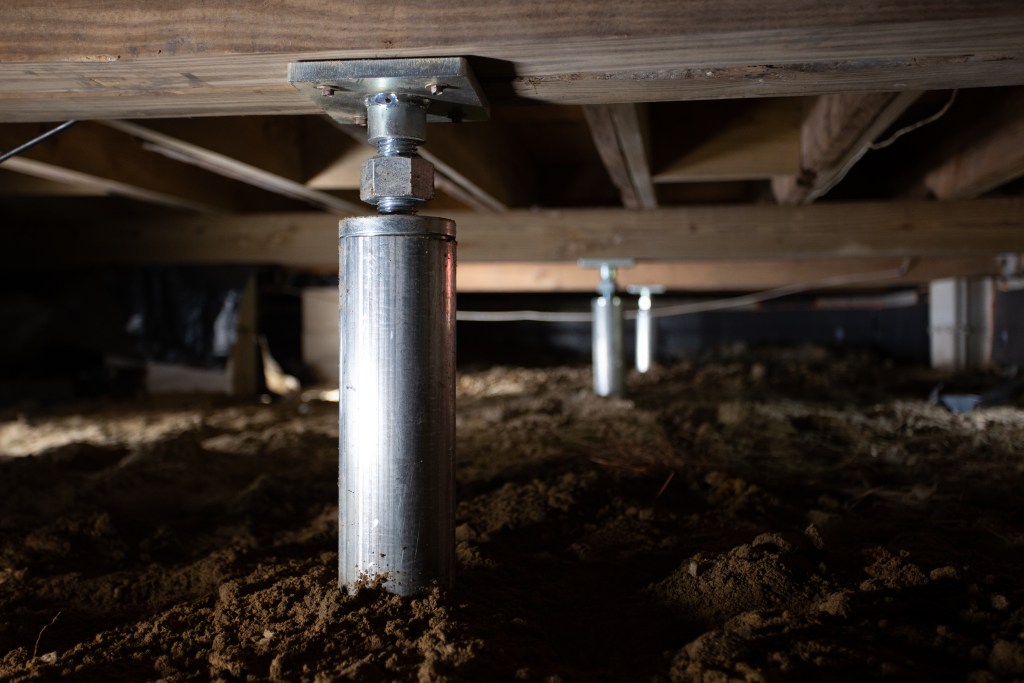
Fortifies Your Home’s Supports
Issues deep in the crawl space can make their way to your support joists or beams, weakening them. When this happens, you may notice spots on your floor that are more fragile than others, being particularly bouncy or saggy. This can be a result of dry rot or even crumbling, wet supports. Using crawl space support jacks, you can feel the safety of a stronger foundation and a more level floor.

Improves Air Quality
Due to the stack effect, the moldy, stale, or pest-infested air festering in your crawl space will rise into your home and affect your living space. Mold spores or smells and toxins from pest droppings may bother those in your home with allergies or asthma. Encapsulation makes your crawl space a less inviting place for mold to form and for pests to gather.
Crawl Space Repair & Encapsulation Tips & Mistakes
Mistakes to Avoid
- Repeatedly Calling Pest Control
While it’s true that pest control can get rid of the insects in your crawl space, they don’t deal in sealing your crawl space from the outdoor elements that attract pests. The most common crawl space pests are rats, mice, cockroaches, termites, carpenter ants, and even stray animals. After you have an exterminator rid your crawl space of pests once, you’ll want to have crawl space experts completely seal it off with a 20-mil thick vapor barrier, dehumidifier, crawl space vent covers, and more.
- Doing DIY Crawl Space Repair
Many homeowners understandably try to fix their crawl space problems on their own using one or two store-bought solutions like flammable spray foam or dehumidifiers. These at-home solutions may have a backward effect on your crawl space, as spray foam tends to lock in moisture, helping mold accelerate underneath it. Installing a dehumidifier by itself may also not be safe; if you leave your crawl space vents unsealed, it may end up breaking from a flood or by pest interference. Encapsulation is a multi-faceted solution of services and products that all work together to create a clean, dry crawl space. Experts don’t recommend picking and choosing just a few.
- Ignoring Other Foundation Issues in Your Home
Since many crawl space, basement, and foundation issues grow from the same root causes, if you’re seeing problems in one area, you may see them in other areas as well. If you’re seeing wall cracks in your basement, or even drywall in your upstairs living area, all these issues are likely connected.
Helpful Tips
- Hire A Specialty Crawl Space and Foundation Company
It can be daunting to hire a contractor, but the best thing you can do is your homework. Research repair companies that can help you, and make sure you learn as much as you can about a company. Check out reviews and third-party resources like the Better Business Bureau and ask for references. Don’t forget to inquire about contractor essentials like licensing, insurance, certificates, warranties, written estimates and contracts, and other important documents. You’ll be bringing these people into your home, so you need to feel comfortable with them and confident in their abilities.
- Have Regular Inspections Done To Your Home
Our certified field inspectors will complete a free thorough assessment of your crawl space and other issues, and then discuss our findings with you as well as your goals with a repair project. Then, the inspector will be able to put together an estimate that includes a plan for repair with solutions customized to meet your specific repair needs. We’ll also will consider your budget and go over financing options. Take your time to review this estimate and don’t hesitate to follow-up with your inspector with any questions or concerns.
- Encapsulation Improves Your Home’s Market Value
Whether you intend to be a lifelong owner of your home or you’re thinking about selling soon, your house is going to be on the market at some point. Is it ready and has it retained its value? A lot can affect your home’s value and resale value, including the condition of the crawl space. Why not save yourself a lot of time and headaches and get it repaired now? You could sell as-is, but you’ll still have to fill out the Seller’s Property Disclosure form. With this form, you’ll have to disclose any known past or current problems like moisture and water, flooding, cracks, settling, termite presence and damage, and more. Plus, things like foundation issues can reduce your home’s resale value by 10 to 30 percent, and homebuyers could have problems getting a mortgage. Most homebuyers expect a home to be free of problems, and a safe and healthy house is much more attractive to potential owners as opposed to one with mold and uneven floors.

Find your service area
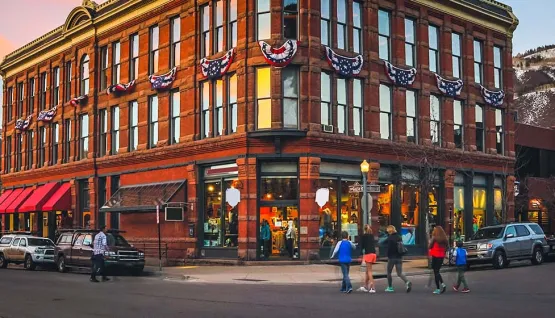
Aspen, Colorado
Known as one of the most famous ski towns in the world, Aspen, CO sees its fair share of foundation, basement, and crawl space damage due to spring thaws and winter freezes.
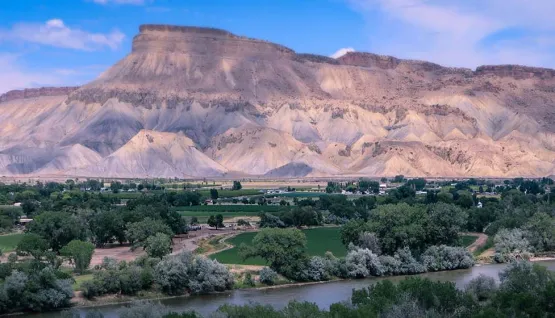
Clifton
If your Clifton, CO home is experiencing issues with foundation slab cracking, basement, or crawl space water damage, or failing wall supports, contact our team at FRWC.
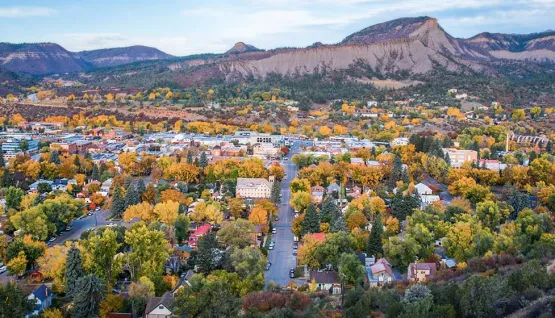
Durango
With Durango’s soil being primarily clay, this can cause a multitude of issues with your home’s foundation and basement because of its poor drainage capabilities.
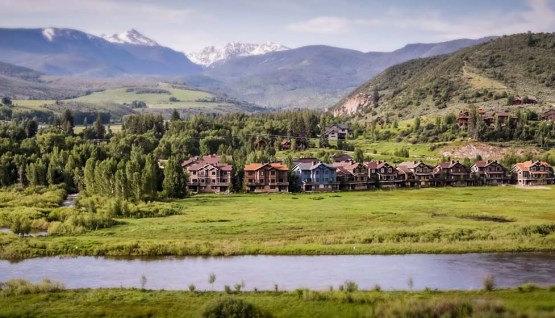
Edwards
Located just 15 miles away from Vail, Edwards, CO, is a sleepy ski town nestled in the heart of the mountains. Unfortunately, the winter season brings its fair share of damage to homeowners' basements and foundations.

Fruita
Within the Grand Valley, Fruita, CO homeowners see their fair share of foundation, basement, crawl space, and concrete damage around their homes.

Glenwood Springs
Known for their natural hot springs, Glenwood Springs, CO is no stranger to the damaging effects water can have on foundations, basements, and concrete structures.

Grand Junction, Colorado
For Grand Junction, CO, homes both big and small, old and new, foundation and basement damage can be both easy to miss and expensive to fix.
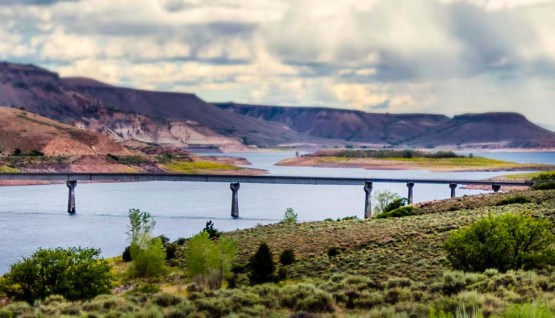
Montrose
Are you looking to buy a home in Montrose, CO? Identifying foundation issues is an important part of selecting a new home to ensure you make a sound investment, while protecting it for the future.
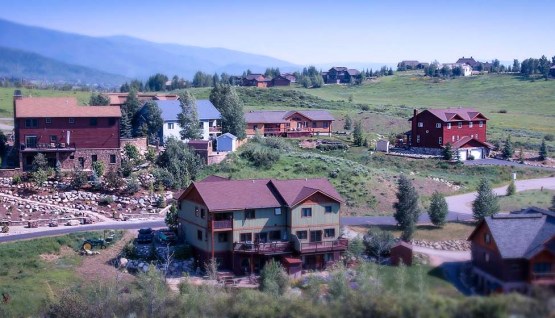
Steamboat Springs
The mix of sand and clay soils in Steamboat Springs, CO can make for a variety of water drainage issues for your foundation and basement.



